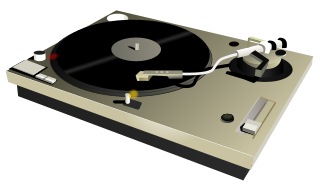
A phonograph, later called a gramophone, and since the 1940s a record player, or more recently a turntable, is a device for the mechanical and analogue reproduction of recorded sound. The sound vibration waveforms are recorded as corresponding physical deviations of a spiral groove engraved, etched, incised, or impressed into the surface of a rotating cylinder or disc, called a "record". To recreate the sound, the surface is similarly rotated while a playback stylus traces the groove and is therefore vibrated by it, faintly reproducing the recorded sound. In early acoustic phonographs, the stylus vibrated a diaphragm that produced sound waves coupled to the open air through a flaring horn, or directly to the listener's ears through stethoscope-type earphones.
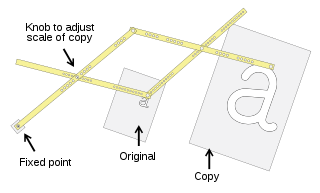
A pantograph is a mechanical linkage connected in a manner based on parallelograms so that the movement of one pen, in tracing an image, produces identical movements in a second pen. If a line drawing is traced by the first point, an identical, enlarged, or miniaturized copy will be drawn by a pen fixed to the other. Using the same principle, different kinds of pantographs are used for other forms of duplication in areas such as sculpting, minting, engraving, and milling.

An audio tape recorder, also known as a tape deck, tape player or tape machine or simply a tape recorder, is a sound recording and reproduction device that records and plays back sounds usually using magnetic tape for storage. In its present-day form, it records a fluctuating signal by moving the tape across a tape head that polarizes the magnetic domains in the tape in proportion to the audio signal. Tape-recording devices include the reel-to-reel tape deck and the cassette deck, which uses a cassette for storage.

Phonograph cylinders are the earliest commercial medium for recording and reproducing sound. Commonly known simply as "records" in their heyday, a name which has been passed on to their disc-shaped successor, these hollow cylindrical objects have an audio recording engraved on the outside surface which can be reproduced when they are played on a mechanical cylinder phonograph. The first cylinders were wrapped with tin foil but the improved version made of wax was created a decade later, after which they were commercialized. In the 1910s, the competing disc record system triumphed in the marketplace to become the dominant commercial audio medium.
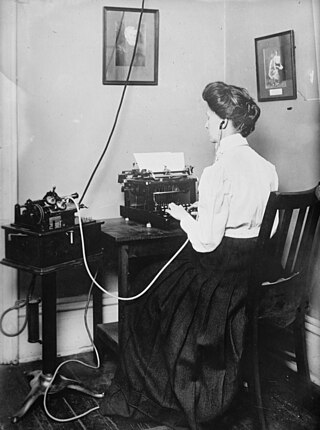
Dictaphone was an American company founded by Alexander Graham Bell that produced dictation machines. It is now a division of Nuance Communications, based in Burlington, Massachusetts.

Pathé Records was an international record company and label and producer of phonographs, based in France, and active from the 1890s through the 1930s.
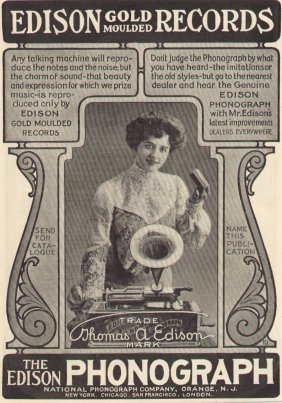
Edison Records was one of the early record labels that pioneered sound recording and reproduction, and was an important and successful company in the early recording industry.

Mastering, a form of audio post production, is the process of preparing and transferring recorded audio from a source containing the final mix to a data storage device, the source from which all copies will be produced. In recent years, digital masters have become usual, although analog masters—such as audio tapes—are still being used by the manufacturing industry, particularly by a few engineers who specialize in analog mastering.

Blue Amberol Records was the trademark name for cylinder records manufactured by Thomas A. Edison, Inc. in the US from 1912 to 1929. They replaced the 4-minute black wax Amberol cylinders introduced in 1908, which had replaced the 2-minute wax cylinders that had been the standard format since the late 1880s. Blue Amberols can play for as long as 4 minutes and 45 seconds and have a surface layer of the "indestructible" plastic celluloid, which Edison tinted a trademark blue color. Edison brand phonographs designed to play Amberol cylinders were named Amberolas.
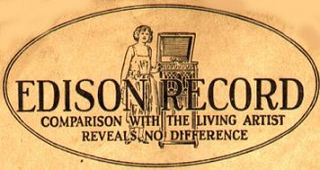
The Edison Diamond Disc Record is a type of phonograph record marketed by Thomas A. Edison, Inc. on their Edison Record label from 1912 to 1929. They were named Diamond Discs because the matching Edison Disc Phonograph was fitted with a permanent conical diamond stylus for playing them. Diamond Discs were incompatible with lateral-groove disc record players, e.g. the Victor Victrola, the disposable steel needles of which would damage them while extracting hardly any sound. Uniquely, they are just under 1⁄4 in thick.

Wire recording, also known as magnetic wire recording, was the first magnetic recording technology, an analog type of audio storage. It recorded sound signals on a thin steel wire using varying levels of magnetization. The first crude magnetic recorder was invented in 1898 by Valdemar Poulsen. The first magnetic recorder to be made commercially available anywhere was the Telegraphone, manufactured by the American Telegraphone Company, Springfield, Massachusetts in 1903.

The overwhelming majority of records manufactured have been of certain sizes, playback speeds, and appearance. However, since the commercial adoption of the gramophone record, a wide variety of records have also been produced that do not fall into these categories, and they have served a variety of purposes.

A Dictabelt recording from a motorcycle police officer's radio microphone stuck in the open position became a key piece of evidence cited by the House Select Committee on Assassinations (HSCA) in their conclusion that there was a conspiracy behind the assassination of John F. Kennedy on November 22, 1963. Made on a common Dictaphone-brand dictation machine that recorded sound in grooves pressed into a thin vinyl-plastic belt, the recording gained prominence among Kennedy assassination conspiracy theorists following the HSCA's 1978 conclusion, based in part on this evidence, that there was a "high probability" that Lee Harvey Oswald did not act alone and that the Kennedy assassination was the result of a conspiracy.

The Graphophone was the name and trademark of an improved version of the phonograph. It was invented at the Volta Laboratory established by Alexander Graham Bell in Washington, D.C., United States.
The history of sound recording - which has progressed in waves, driven by the invention and commercial introduction of new technologies — can be roughly divided into four main periods:
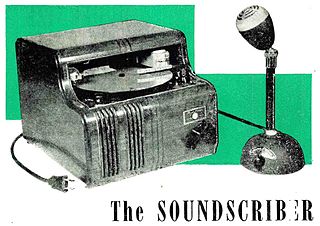
SoundScriber is a dictation machine introduced in 1945 by The SoundScriber Corp.. It records sound with a groove embossed into soft vinyl discs with a stylus. Similar competing recording technologies are the Gray Audograph and Dictaphone DictaBelt. The machine can record 15 minutes of dictation on each side of a thin (.01-inch) flexible 6-inch vinyl disc spinning at a rate of 33+1⁄3 RPM, at a density of 200 grooves per inch. The discs originally cost about 10 cents each. The machine has two tonearms: a recording arm driven by a worm gear that creates the groove with a diamond stylus, and a pickup arm with a sapphire stylus for playback. A foot-operated playback/pause—and-reverse switch is used for transcribing.

The Gray Audograph was a dictation machine format introduced in 1945. It recorded sound by pressing grooves into soft vinyl discs, like the competing, but incompatible, SoundScriber. It was manufactured by the Gray Manufacturing Company of Hartford, Connecticut, United States.

A dictation machine is a sound recording device most commonly used to record speech for playback or to be typed into print. It includes digital voice recorders and tape recorder.
In the field of audio recording, an aluminum disc is a phonograph record made of bare aluminum, a medium introduced in the late 1920s for making one-off recordings. Although sometimes used for making amateur studio or home recordings or in coin-operated "record-your-voice" booths at fairs and arcades, during the first half of the 1930s bare aluminum discs were primarily used to record radio broadcasts for the private transcription disc archives of performers or sponsors.
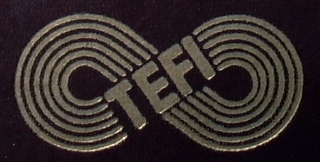
The Tefifon is an audio playback format, developed and manufactured in Germany, that utilizes cartridges loaded with an endlessly looped reel of plastic tape. It is somewhat similar to the later 4-track and 8-track magnetic audio tape cartridges, but with grooves engraved into the tape, like a phonograph record. The grooves were engraved in a helical fashion across the width of the tape, in a manner similar to Dictaphone's Dictabelt format. The grooves are read with a stylus and amplified pickup in the player's transport. A Tefifon cartridge, known as a "Tefi", can hold up to four hours of music; therefore, most releases for the format are usually compilations of popular hits or dance music, operas, and operettas. Tefifon players were not sold by television and radio dealers in Germany, but rather sold directly by special sales outlets affiliated with Tefi.


















